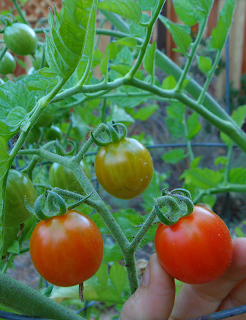 |
| My Seed Poppies in June |
Happy First Harvest!
It’s Lammas, the ancient Anglo-Saxon festival celebrating
the first harvest. On this holiday, halfway between summer solstice and autumn
equinox, ancients gathered grain and baked bread to share in hopes that later
harvests would be bountiful. In ancient Celtic tradition, Lughnasadh is a time
for harvest wild caneberries as well as grains.
Here in the Santa Cruz mountains, we have little corn and no
wheat to harvest. But I do have seeds from
poppies planted back in early April, and a perfect dry summer day for harvesting.
Blackberries are beginning to ripen along rural pathways, so like the Celts we
can graze in nature. August is a rich month for harvests, and the easiest time
of year to eat locally on a budget. Below are a few foods to look for from your
local farm this month.
 |
| Wild Blackberries: the Promise of More |
1.
Caneberries: raspberries, blackberries, ollalieberries,
and other hybrids: Look for these at farmers markets and farm stands, or in the
local produce section of your grocery store. Or check the phone book for
You-Pick farms for best price and optimum freshness. As noted above, you can
also scope out roadsides and byways for wild blackberries.
 |
| Backyard Picking |
2.
Tomatoes: They’re just starting to come in. Many
varieties ripen all at once, and have limited shelf life so by the month’s end
you’ll be able to pick them up inexpensively. For the best deal, try visiting
the farm stand or farmers market late on a hot day. You might be able to pick
up a great deal on a huge quantity, if you don’t mind getting a few squishy
ones. To preserve the bounty you can dehydrate them or make
tomato
sauce to freeze.
3. Peppers: Both sweet and hot peppers are coming in like crazy, and
will be for awhile. They love hot weather, and hot varieties get hotter
as the season heats up. They pair famously with in-season tomatoes and
eggplant. The latter is a bit more fussy crop than tomatoes and peppers,
so is rarely cheap. However, the latter part of the month holds promise
for eggplant-loving bargain hunters.
 |
| Thawing Frozen Basil for Winter Cooking |
4.
Basil and other Italian herbs: Oregano, thyme, marjoram, and chives
are readily available. Now is the time to make
pesto.
In the wheel of the seasons, basil will never be cheaper or more plentiful.
Pesto can be frozen, or
freeze
basil leaves or chives themselves for use in winter soups and stews. Basil also pairs
perfectly with in-season tomatoes, whether they’re cooked or raw. Marjoram, thyme, and oregano can be hung upside down and dried, then crumbled for use during the winter. Or use large quantities of them to perk up your palate.
 |
| Tell Your Neighbor: I Like Squash! |
5.
Summer squash: All sorts of varieties will be available
this month. You might employ the technique above of visiting the farmers market
late in the day and making an offer. Or perhaps your neighbors are growing
squash. If you mention that you like squash you might end up with fresh
squash
on your doorstep, and help your neighbors keep up with their harvest in the
process.
6. Green beans: At the peak of their season, they’re coming
in like crazy, yet still picked young enough to be tender. As the season
progresses, they’ll become woodier. Get ‘em early in the month, don’t wait.
 |
| My Neighbor's SC Mountain Corn! |
7.
Corn: One of the most frequently
genetically
engineered foods (GMOs), grown on corporate monoculture farms with
pesticides, corn is a crop that I hesitate to recommend. However, organic corn
in the US, at least so far, is guaranteed GMO-free. Let’s support our local
organic corn-growers so we’ll continue to have this alternative to genetically
engineered corn. Sure, the mass-produced stuff is cheaper; it’s subsidized by
taxpayers. Buying local organic might cost a bit more money, but it’s all corn,
with no odd pathogen DNA. Mid to late August is a good time to cut a deal on
it.
8.
Peaches and Nectarines: According to the Environmental
Working Group (EWG),
peaches
top of the Dirty Dozen list of produce containing the most dangerous
pesticides. Nectarines are about halfway down the list. Pesticides penetrate
their thin skins and permeate the fruit so that washing them is of limited
value. Ask questions: just because you find it at the farmers market doesn’t
mean it’s organic. The end-of-the-day bargain approach can be employed with
these soft fruits too. You can
freeze
or dehydrate them to enjoy during the winter.
9.
Apricots and Plums: Get these early in August, before
they go out of season. There are many varieties of Pluots, Apriums, and other
hybrids that you might enjoy. Try
making
some jam or
freezing
them for future enjoyment.
 |
| Lammas Poppies Ready for Harvest |
10.
Poppyseed: If you can find it, fresh poppyseed is at the
height of harvest. Even more rewarding: grow your own next year.
Heirloom
Pepperbox is extremely hardy and produces large red, pink, violet, and
purple flowers that attract loads of bees.
Hungarian
Breadseed, with a more subtle cream-colored flower, is not as prolific, but
provides the beautiful blue-black poppyseeds that we commonly see in fine baked
goods.
Have other favorite August-harvested produce?
Leave a comment and let us know about it!







No comments:
Post a Comment